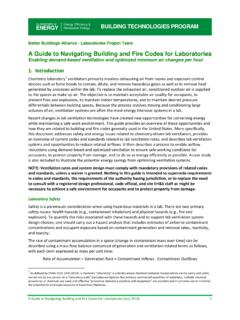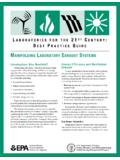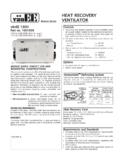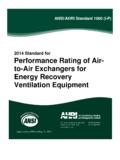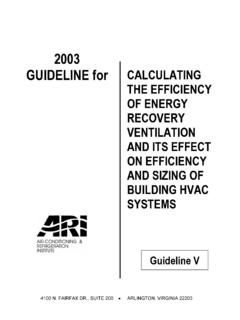Transcription of LABORATORIES FOR THE 21ST ENTURY BEST PRACTICES
1 1 LABORATORIES FOR THE 21st CENTURY BEST PRACTICES NREL s Science & Technology Facility incorporates many energy -saving features, including energy recovery . Photo by Pat Corkery, NREL/PIX 15010. For more information, visit: energy recovery IN LABORATORY FACILITIES This guide is part of a series on energy recovery best PRACTICES for LABORATORIES . It was produced by LABORATORIES for the 21st Century (Labs 21), a joint program of the Environmental Protection Agency and the Department of energy . Geared toward architects, engineers, and facility managers, these guides provide information about technologies and PRACTICES to use in designing, constructing, and operating safe, sustainable, high-performance LABORATORIES .
2 2 Introduction LABORATORIES typically require 100% outside air for ventilation at higher rates than other commercial buildings. Minimum ventilation is typically provided at air change per hour (ACH) rates in accordance with codes and adopted design standards including Occupational Safety and Health Administration (OSHA) Standard (4 to 12 ACH non-mandatory) or the 2011 American Society of Heating, Refrigerating and Air Conditioning Engineers (ASHRAE) Applications Handbook, Chapter 16 Laborato-ries (6 to 12 ACH). While OSHA states this minimum ventilation rate should not be relied on for protec-tion from toxic substances released into the laboratory it specifically indicates that it is intended to provide a source of air for breathing and for input to local ventilation devices ( , chemical fume hoods or exhausted bio-safety cabinets), to ensure that laboratory air is continually replaced preventing the increase of air concentrations of toxic substances during the working day, direct air flow into the laboratory from non-laboratory areas and out to the exterior of the building.
3 The heating and cooling energy needed to condition and move this outside air can be 5 to 10 times greater than the amount of energy used in most office buildings. In addition, when the required ventilation rate exceeds the airflow needed to meet the cooling load in low-load LABORATORIES , additional heating energy may be expended to reheat dehumidified supply air from the supply air condition to prevent over cooling. In addition to these low-load LABORATORIES , reheat may also be required in adjacent spaces such as corridors that pro-vide makeup air to replace air being pulled into negative-pressure LABORATORIES .
4 Various types of energy recovery devices and systems can substantially reduce heating and cooling energy required for conditioning spaces in LABORATORIES . Heating and cooling systems can be downsized when energy recovery is used because these systems reduce peak heating and cooling requirements. Heating and cooling systems can also be downsized by capturing heat generated in high-load spaces and transferring it to spaces requiring reheat. Figure 1. Cross Sections (Front and Side) of Enthalpy Wheel System with Purge Section There are many opportunities for energy recovery in LABORATORIES . This guide includes descriptions of sev-eral air-to-air energy recovery devices and methods, such as using enthalpy wheels (Figure 1), heat pipes, or run-around loops in new construction.
5 These devices generally recover energy from exhaust air. This recovered energy is used to precondition supply air during both cooling and heating modes of operation. In addition to air-to-air energy recovery options, this guide includes a description of a water-to-water heat recovery system that collects heat from high-load spaces and transfers it to spaces that require reheat. While air-to-air recovery devices provide significant energy reduction, in some laboratory facilities the amount of energy available in the exhaust air exceeds the pre-heat and pre-cooling needed 3 to maintain supply air conditions.
6 During these periods of time, controls typically reduce the energy recovery capacity to match the reduced load. If the energy recovered in the exhaust is not needed then it is rejected from the facility. By using a water-to-water recovery system, it is possible to significantly reduce overall building energy use by reusing heating or cooling energy generated in the building before it is rejected to the outdoors. Laboratory managers are encouraged to perform a life-cycle cost analysis of an energy - recovery tech-nology to determine the feasibility of its application in their laboratory. Usually, the shortest payback periods occur when the heating and cooling load reduction provided by an energy recovery system allows the laboratory to install and use smaller heating ( , hot water or steam) and cooling ( , chilled water) systems that eliminate energy waste.
7 Technology Description Air-to-Air recovery Devices Air-to-air energy recovery devices exchange energy from one stream of air to another. The air being exhausted contains sensible (heat) and latent (water vapor) energy . Both types of energy can be recovered; however, not all air-to-air recov-ery devices exchange both types of energy . The effectiveness of an energy recovery device reflects the efficiency of the device in recovering available energy . Most devices have a rating for sensible effectiveness; some also have a rating for latent effectiveness and total effectiveness. It should be not-ed that in humidified buildings in cold climates, the actual performance of the energy recovery device may be limited (reduced effectiveness) by controls that prevent freezing or moisture condensation in the exhaust air stream.
8 These air-to-air energy recovery devices increase the pres-sure drop that must be provided by either the supply or e x-haust fans. Enthalpy wheels generally have a lower pressure drop than heat pipes and run-around loops, although actual pressure drop depends on the particular design. An addition-al pressure drop of no more than 1-inch water gauge (1-in. ) in the supply and exhaust air streams is a reasonable design goal, and it will minimize the increase in fan energy associated with these devices. For example, an increase in pressure drop of 1-in. on a 76% efficient fan and a 95% efficient motor assembly results in an increase in fan energy of watt per cubic foot of air per minute (W/cfm).
9 The total increase for supply and exhaust fans together in this example would be around W/cfm. For laboratory applications, the design face velocity of recovery devices in air handling systems is usually 500 fpm. However, lower face velocities will result in lower pressure-drops, higher effectiveness, and lower operating costs. The trade-off is physically larger air handling equipment, larger mechanical space requirements and, possibly, higher first-cost. It is important to note that an energy recovery device will operate more efficiently with a variable-air-volume (VAV) system than with a constant-volume system, because VAV systems typically operate at face velocities lower than those of the peak design condition.
10 If a Key Terms Effectiveness: The ratio of actual energy recovered to theoretical energy that could be recovered. Latent energy : The energy contained in moisture. Latent effectiveness: Proportional to the ratio of the difference between the humidity ratio of the outside air and the supply air, and the difference between the humidity ratio of the exhaust air and the outside air. Sensible energy : The energy associated with a temperature difference. Sensible effectiveness: Proportional to the ratio of the difference between the dry-bulb temperature of the outside air and supply air, and the difference be-tween the dry-bulb temperature of the exhaust air and the outside air.
